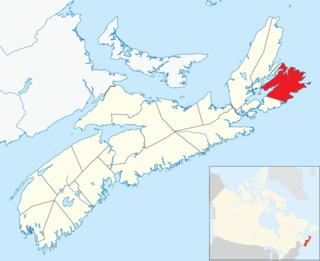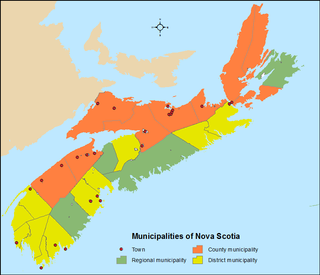
Cape Breton Island is a rugged and irregularly shaped island on the Atlantic coast of North America and part of the province of Nova Scotia, Canada.

Cape Breton University (CBU) is a public university located in Sydney, Nova Scotia, Canada. It is the only post-secondary degree-granting institution within the Cape Breton Regional Municipality and on Cape Breton Island. The university is enabled by the Cape Breton University Act passed by the Nova Scotia House of Assembly. Prior to this, CBU was enabled by the University College of Cape Breton Act (amended). The University College of Cape Breton's Coat of Arms were registered with the Canadian Heraldic Authority on May 27, 1995.

Sydney is a former city and urban community on the east coast of Cape Breton Island in Nova Scotia, Canada within the Cape Breton Regional Municipality. Sydney was founded in 1785 by the British, was incorporated as a city in 1904, and dissolved on 1 August 1995, when it was amalgamated into the regional municipality.

Cape Breton County is one of eighteen counties in the Canadian province of Nova Scotia. It is located on Cape Breton Island.

The Nova Scotia New Democratic Party is a social-democratic, progressive provincial party in Nova Scotia, Canada. It is the provincial entity of the federal New Democratic Party (NDP). It was founded as the Co-operative Commonwealth Federation (CCF) in 1932, and became the New Democratic Party in 1961. It became the governing party of Nova Scotia following the 2009 Nova Scotia election, winning 31 seats in the Legislature, under the leadership of Premier Darrell Dexter. It is the first New Democratic Party in Atlantic Canada to form a government, and the second to form a government in a province east of Manitoba. The party lost government at the 2013 election, losing 24 seats, including Dexter's seat. Gary Burrill, the party’s leader from 2016 to 2022, is credited with bringing the party back to its left-wing roots. The party currently holds 6 seats in the Legislature and has been led by Claudia Chender since June 2022.

Cape Breton Regional Municipality is the Canadian province of Nova Scotia's second largest municipality and the economic heart of Cape Breton Island. As of 2021 the municipality has a population of 93,694. The municipality was created in 1995 through the amalgamation of eight municipalities located in Cape Breton County.
The Cape Breton Labour Party was a social democratic provincial political party in Nova Scotia, Canada, which drew most of its support from Cape Breton Island, the northern part of the province of Nova Scotia.
Kenzie MacNeil was a Canadian songwriter, performer, producer and director in television, film, radio and stage, and a former Conservative Party of Canada candidate. MacNeil completed a Bachelor of Arts degree from St. Francis Xavier University. He also studied at the University of Botswana in Lesotho and Swaziland while accompanying his parents on field work with CIDA in Africa for three years.

Maritime Union is a proposed political union of the three Maritime provinces of Canada – New Brunswick, Nova Scotia, and Prince Edward Island – to form a single new province. This vision has sometimes been expanded to a proposed Atlantic Union, which would also include the province of Newfoundland and Labrador.
Glace Bay is a community in the eastern part of the Cape Breton Regional Municipality in Nova Scotia, Canada. It forms part of the general area referred to as Industrial Cape Breton.
John W. Morgan,, is a Canadian lawyer, politician, and businessman. He was the mayor of the Cape Breton Regional Municipality (CRBM) in Nova Scotia from 2000 to 2012.

Canadian Gaelic or Cape Breton Gaelic, often known in Canadian English simply as Gaelic, is a collective term for the dialects of Scottish Gaelic spoken in Atlantic Canada.
Renwick Brook Park is an urban park located in the community of Glace Bay, part of the Cape Breton Regional Municipality in Nova Scotia, Canada. The park includes over 4 kilometres (2.5 mi) of walking trails spread through an area of over 10 hectares, winding along a quiet brook. The park is adjacent to both the Cameron Bowl Ball Park and Queen Elizabeth Park, which all together make up a green space of more than 17 hectares in downtown Glace Bay.
Cecil Phillip Clarke is a politician in Nova Scotia, Canada. He was the mayor of the Cape Breton Regional Municipality from 2012 to 2020, and represented the riding of Cape Breton North in the Nova Scotia House of Assembly, from 2001 to 2011 as a Progressive Conservative.
Boisdale is a community in the Canadian province of Nova Scotia, located in the Cape Breton Regional Municipality on Cape Breton Island. It was named for Lochboisdale, the main village of the island of South Uist in the Outer Hebrides of Scotland. Neil Campbell was granted land in the area in 1836. In 1821, Thomas Lockman, an Irishman who came to Cape Breton in 1799 and lived at Lloyds Cove, petitioned for land, and got a grant next to Neil Campbell's lot in 1842. Angus McIntyre got a grant in 1846, and in 1869, land at what was then called Boisdale was granted to Dugald O'Henley. Farming and lumbering were the basic industries. In 1840, a small log church was constructed by Father John Grant on where the present-day church resides. It was replaced by a new building in 1862, which burned down in September 1928. In 1846, Boisdale Parish was officially erected. A post office was established at Boisdale Chapel in 1854. On October 1, 1873 a new post office was established with Michael McIntyre as office keeper. In 1874, the total population of Boisdale, was that of 500. During this time, the area had 1 store, 3 sawmills, 1 grist mill, and a post office, of which mail was delivered bi-weekly. By 1908, it contained 1 hotel, 2 general stores, 1 saw mill, and 2 gristmills. The population at that time, was 300. In 1915, a newer 40,000 gallon open-wood tank was built replacing an older 40,000 gallon wood tank, for the water services within the area. Father Alexander F. MacGillivray, whom was the fifth pastor of Boisdale, had installed the bell within St. Andrew's Church in Boisdale, in 1882, and had built the Glebe house there in 1890. A new and larger bell, cast by the Meneely Bell Company of New York, was installed in St. Andrew's Church, by Father MacGillivray, on Nov. 14, 1897. In 1921, Father Gillis built St. Andrew's Parish Hall, James Johnston of Red Islands, Nova Scotia was the contractor. The formal opening of the hall was held on September 13, 1921. The original St. Andrew's Parish Church was destroyed by fire on Sunday, September 11, 1927. Construction of a new stone church commenced in June 1929, with help from workers from Quebec. The design style of the church was inspired by the Norman architecture as well as the St Mary the Virgin, Iffley church in England. Link, Weber, and Bowers, architects hailing from Pittsburgh, Pennsylvania, designed the architecture of the church. The approximate cost of the church was $55,000, but the exterior walls had to be repointed during the summer of 1930, which added an extra $7,500 to the total cost. The new church was blessed on Sunday, August 31, 1930, by Bishop James Morrison, assisted by the late Bishop Alexander MacDonald. In 1931, the total population of Boisdale was 449. There was also a train station located on Station Road, in Boisdale during this time. The former Glebe House for St. Andrew's Church was burnt down in 2011, due to a fire. Dugald Smith was the teacher in 1839, and a school-house had been constructed by that time. A new school-house was completed in 1917. Education within the area dates back to the early 1800s, with the Boisdale Consolidated School closing in 2003. The enrolment for the school, in the 1957–1958 academic year, were 82 students, and 3 teachers. By the 1987 Academic year, there were only 21 students, all within grades primary-second, and fourth. In 1943, within what is now known as Ironville, then known as Boisdale Barrachois until 1907, a youth summer camp was built. The two-week summer camp operated from 1943, until its closure in the 1980s. Efforts were made in 1997 to re-open the camp in the spring of 1998. The camp officially closed in 2010, due to the deterioration of some of the buildings. The property in which the youth camp was on, was sold in 2013. In August 1977, the community of Boisdale, as well as Father Webb, unveiled and held a ceremony for the opening of an indoor stone, ice-skating rink. Father Webb also built a Co-op store, in the 70s. A new hall above the store replaced the old Holyrood Hall, which burned down on December 18, 1975. By 1956, the population of Boisdale was 133. Over the years the population decreased, down to 138 by 1991, and estimated to be 105 by the 2001 Census.To the Hill of Boisdale,a book on the genealogical history of Boisdale was published in 1986, and later in a revised edition in 2001, by Father Allan MacMillan, then Priest of the Diocese of Antigonish. Highland Gold Maple, a family-owned and operated sugar maple producer, has been operating within the area for over fifteen years. In late April 2018, their operation burned to the ground due to a fire. By March 2019, Highland Gold Maple had rebuilt the Sugar Shack and are back in operation.
David Nelson Muise was a Canadian politician. He was mayor of the Cape Breton Regional Municipality, Nova Scotia from 1997 to 2000. He also represented the electoral district of Cape Breton West in the Nova Scotia House of Assembly from 1978 to 1981. He was a member of the Nova Scotia Liberal Party.

Greenlink Rotary Park Trail System is a Canadian urban park located in the community of Sydney, part of Nova Scotia's Cape Breton Regional Municipality. The park incorporates the Greenlink Trail System, the Rotary Park Off Leash Park, as well as a disc golf course. Much of the park is forested, with ponds, a stone dam, and streams in the valleys; a few acres are open lawn area, suitable for informal recreation. The park encompass 52 acres (21 ha) within the former city's boundaries.

The Canadian province of Nova Scotia is divided into 49 municipalities, of which there are three types: regional (4), town (25), and county or district municipality (20).










